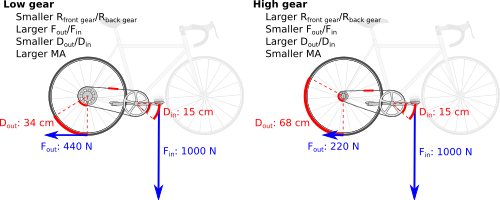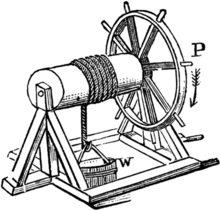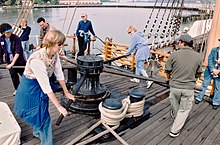Mechanical advantage is a measure of the force amplification achieved by using a tool, mechanical device or machine system. The device preserves the input power
and simply trades off forces against movement to obtain a desired
amplification in the output force. The model for this is the law of the lever. Machine components designed to manage forces and movement in this way are called mechanisms.
An ideal mechanism transmits power without adding to or subtracting from
it. This means the ideal mechanism does not include a power source, is
frictionless, and is constructed from rigid bodies
that do not deflect or wear. The performance of a real system relative
to this ideal is expressed in terms of efficiency factors that take
into account departures from the ideal.
Lever
The lever is a movable bar that pivots on a fulcrum
attached to or positioned on or across a fixed point. The lever
operates by applying forces at different distances from the fulcrum, or
pivot. The location of the fulcrum determines a lever's class.
Where a lever rotates, continuously, it functions as a rotary
2nd-class lever. The motion of the lever's end-point describes a fixed
orbit, where mechanical energy can be exchanged. (see a hand-crank as
an example.)
In modern times, this kind of rotary leverage is widely used;
see a (rotary) 2nd-class lever; see gears, pulleys or friction drive,
used in a mechanical power transmission scheme. It is common for
mechanical advantage to be manipulated in a 'collapsed' form, via the
use of more than one gear (a gearset). In such a gearset, gears having
smaller radii and less inherent mechanical advantage are used. In order
to make use of non-collapsed mechanical advantage, it is necessary to
use a 'true length' rotary lever. See, also, the incorporation of
mechanical advantage into the design of certain types of electric
motors; one design is an 'outrunner'.
As the lever pivots on the fulcrum, points farther from this pivot move faster than points closer to the pivot. The power
into and out of the lever is the same, so must come out the same when
calculations are being done. Power is the product of force and velocity,
so forces applied to points farther from the pivot must be less than
when applied to points closer in.
If a and b are distances from the fulcrum to points A and B and if force FA applied to A is the input force and FB exerted at B is the output, the ratio of the velocities of points A and B is given by a/b so the ratio of the output force to the input force, or mechanical advantage, is given by
This is the law of the lever, which was proven by Archimedes using geometric reasoning. It shows that if the distance a from the fulcrum to where the input force is applied (point A) is greater than the distance b from fulcrum to where the output force is applied (point B),
then the lever amplifies the input force. If the distance from the
fulcrum to the input force is less than from the fulcrum to the output
force, then the lever reduces the input force. Recognizing the
profound implications and practicalities of the law of the lever,
Archimedes has been famously attributed the quotation "Give me a place
to stand and with a lever I will move the whole world."
The use of velocity in the static analysis of a lever is an application of the principle of virtual work.
Speed ratio
The requirement for power input to an ideal mechanism to equal power
output provides a simple way to compute mechanical advantage from the
input-output speed ratio of the system.
The power input to a gear train with a torque TA applied to the drive pulley which rotates at an angular velocity of ωA is P=TAωA.
Because the power flow is constant, the torque TB and angular velocity ωB of the output gear must satisfy the relation
which yields
This shows that for an ideal mechanism the input-output speed ratio
equals the mechanical advantage of the system. This applies to all mechanical systems ranging from robots to linkages.
Gear trains
Gear teeth are designed so that the number of teeth on a gear is
proportional to the radius of its pitch circle, and so that the pitch
circles of meshing gears roll on each other without slipping. The speed
ratio for a pair of meshing gears can be computed from ratio of the
radii of the pitch circles and the ratio of the number of teeth on each
gear, its gear ratio.
The velocity v of the point of contact on the pitch circles is the same on both gears, and is given by
where input gear A has radius rA and meshes with output gear B of radius rB,
therefore,
where NA is the number of teeth on the input gear and NB is the number of teeth on the output gear.
The mechanical advantage of a pair of meshing gears for which the input gear has NA teeth and the output gear has NB teeth is given by
This shows that if the output gear GB has more teeth than the input gear GA, then the gear train amplifies the input torque. And, if the output gear has fewer teeth than the input gear, then the gear train reduces the input torque.
If the output gear of a gear train rotates more slowly than the input gear, then the gear train is called a speed reducer
(Force multiplier). In this case, because the output gear must have
more teeth than the input gear, the speed reducer will amplify the input
torque.
Chain and belt drives
Mechanisms
consisting of two sprockets connected by a chain, or two pulleys
connected by a belt are designed to provide a specific mechanical
advantage in power transmission systems.
The velocity v of the chain or belt is the same when in contact with the two sprockets or pulleys:
where the input sprocket or pulley A meshes with the chain or belt along the pitch radius rA and the output sprocket or pulley B meshes with this chain or belt along the pitch radius rB,
therefore
where NA is the number of teeth on the input sprocket and NB is the number of teeth on the output sprocket. For a toothed belt
drive, the number of teeth on the sprocket can be used. For friction
belt drives the pitch radius of the input and output pulleys must be
used.
The mechanical advantage of a pair of a chain drive or toothed belt drive with an input sprocket with NA teeth and the output sprocket has NB teeth is given by
The mechanical advantage for friction belt drives is given by
Chains and belts dissipate power through friction, stretch and wear,
which means the power output is actually less than the power input,
which means the mechanical advantage of the real system will be less
than that calculated for an ideal mechanism. A chain or belt drive can
lose as much as 5% of the power through the system in friction heat,
deformation and wear, in which case the efficiency of the drive is 95%.
Example: bicycle chain drive
Mechanical
advantage in different gears of a bicycle. Typical forces applied to
the bicycle pedal and to the ground are shown, as are corresponding
distances moved by the pedal and rotated by the wheel. Note that even in
low gear the MA of a bicycle is less than 1.
Consider the 18-speed bicycle with 7 in (radius) cranks and 26 in
(diameter) wheels. If the sprockets at the crank and at the rear drive
wheel are the same size, then the ratio of the output force on the tire
to the input force on the pedal can be calculated from the law of the
lever to be
Now, assume that the front sprockets have a choice of 28 and 52
teeth, and that the rear sprockets have a choice of 16 and 32 teeth.
Using different combinations, we can compute the following speed ratios
between the front and rear sprockets
|
|
input (small) | input (large) | output (small) | output (large) | speed ratio | crank-wheel ratio | total MA |
|---|---|---|---|---|---|---|---|
| low speed | 28 | - | - | 32 | 1.14 | 0.54 | 0.62 |
| mid 1 | - | 52 | - | 32 | 0.62 | 0.54 | 0.33 |
| mid 2 | 28 | - | 16 | - | 0.57 | 0.54 | 0.31 |
| high speed | - | 52 | 16 | - | 0.30 | 0.54 | 0.16 |
The ratio of the force driving the bicycle to the force on the pedal,
which is the total mechanical advantage of the bicycle, is the product
of the speed ratio (or teeth ratio of output sproket/input sproket) and
the crank-wheel lever ratio.
Notice that in every case the force on the pedals is greater than
the force driving the bicycle forward (in the illustration above, the
corresponding backward-directed reaction force on the ground is
indicated). This low mechanical advantage keeps the pedal crank speed
low relative to the speed of the drive wheel, even in low gears.
Block and tackle
A block and tackle
is an assembly of a rope and pulleys that is used to lift loads. A
number of pulleys are assembled together to form the blocks, one that is
fixed and one that moves with the load. The rope is threaded through
the pulleys to provide mechanical advantage that amplifies that force
applied to the rope.
In order to determine the mechanical advantage of a block and
tackle system consider the simple case of a gun tackle, which has a
single mounted, or fixed, pulley and a single movable pulley. The rope
is threaded around the fixed block and falls down to the moving block
where it is threaded around the pulley and brought back up to be knotted
to the fixed block.
The
mechanical advantage of a block and tackle equals the number of
sections of rope that support the moving block; shown here it is 2, 3,
4, 5, and 6, respectively.
Let S be the distance from the axle of the fixed block to the end of the rope, which is A where the input force is applied. Let R be the distance from the axle of the fixed block to the axle of the moving block, which is B where the load is applied.
The total length of the rope L can be written as
where K is the constant length of rope that passes over the pulleys and does not change as the block and tackle moves.
The velocities VA and VB of the points A and B are related by the constant length of the rope, that is
or
The negative sign shows that the velocity of the load is opposite to
the velocity of the applied force, which means as we pull down on the
rope the load moves up.
Let VA be positive downwards and VB be positive upwards, so this relationship can be written as the speed ratio
where 2 is the number of rope sections supporting the moving block.
Let FA be the input force applied at A the end of the rope, and let FB be the force at B on the moving block. Like the velocities FA is directed downwards and FB is directed upwards.
For an ideal block and tackle system there is no friction in the
pulleys and no deflection or wear in the rope, which means the power
input by the applied force FAVA must equal the power out acting on the load FBVB, that is
The ratio of the output force to the input force is the mechanical advantage of an ideal gun tackle system,
This analysis generalizes to an ideal block and tackle with a moving block supported by n rope sections,
This shows that the force exerted by an ideal block and tackle is n times the input force, where n is the number of sections of rope that support the moving block.
Efficiency
Mechanical
advantage that is computed using the assumption that no power is lost
through deflection, friction and wear of a machine is the maximum
performance that can be achieved. For this reason, it is often called
the ideal mechanical advantage (IMA). In operation, deflection,
friction and wear will reduce the mechanical advantage. The amount of
this reduction from the ideal to the actual mechanical advantage (AMA) is defined by a factor called efficiency, a quantity which is determined by experimentation.
As an example, using a block and tackle with six rope sections and a 600 lb load, the operator of an ideal system would be required to pull the rope six feet and exert 100 lbF of force to lift the load one foot. Both the ratios Fout / Fin and Vin / Vout show that the IMA is six. For the first ratio, 100 lbF of force input results in 600 lbF
of force out. In an actual system, the force out would be less than 600
pounds due to friction in the pulleys. The second ratio also yields a
MA of 6 in the ideal case but a smaller value in the practical
scenario; it does not properly account for energy losses such as rope stretch. Subtracting those losses from the IMA or using the first ratio yields the AMA.
Ideal mechanical advantage
The ideal mechanical advantage (IMA), or theoretical mechanical advantage,
is the mechanical advantage of a device with the assumption that its
components do not flex, there is no friction, and there is no wear. It
is calculated using the physical dimensions of the device and defines
the maximum performance the device can achieve.
The assumptions of an ideal machine are equivalent to the
requirement that the machine does not store or dissipate energy; the
power into the machine thus equals the power out. Therefore, the power P is constant through the machine and force times velocity into the machine equals the force times velocity out—that is,
The ideal mechanical advantage is the ratio of the force out of the machine (load) to the force into the machine (effort), or
Applying the constant power relationship yields a formula for this ideal mechanical advantage in terms of the speed ratio:
The speed ratio of a machine can be calculated from its physical
dimensions. The assumption of constant power thus allows use of the
speed ratio to determine the maximum value for the mechanical advantage.
Actual mechanical advantage
The actual mechanical advantage
(AMA) is the mechanical advantage determined by physical measurement of
the input and output forces. Actual mechanical advantage takes into
account energy loss due to deflection, friction, and wear.
The AMA of a machine is calculated as the ratio of the measured force output to the measured force input,
where the input and output forces are determined experimentally.
The ratio of the experimentally determined mechanical advantage to the ideal mechanical advantage is the mechanical efficiency η of the machine,









































